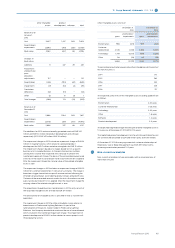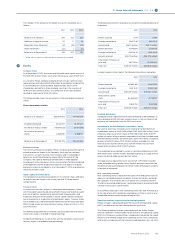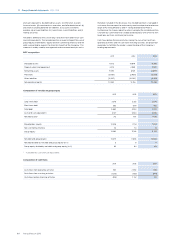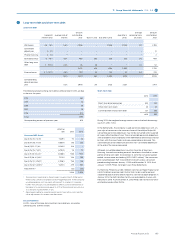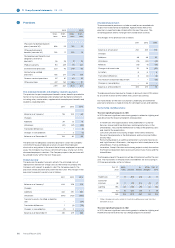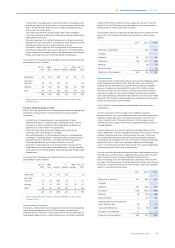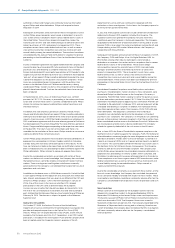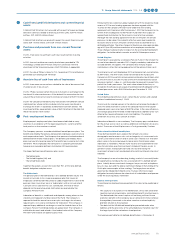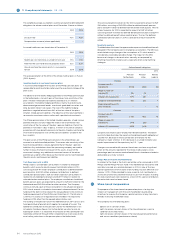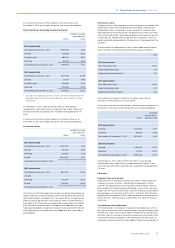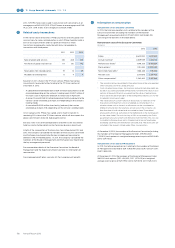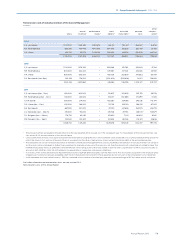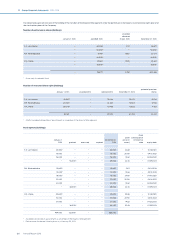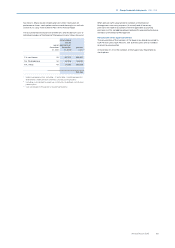Philips 2013 Annual Report Download - page 171
Download and view the complete annual report
Please find page 171 of the 2013 Philips annual report below. You can navigate through the pages in the report by either clicking on the pages listed below, or by using the keyword search tool below to find specific information within the annual report.
11 Group financial statements 11.9 - 11.9 27 28 29 30
Annual Report 2013 171
27 Cash from (used for) derivatives and current financial
assets
A total of EUR 93 million cash was paid with respect to foreign exchange
derivative contracts related to financing activities (2012: EUR 47 million
outflow; 2011: EUR 25 million inflow).
A total of EUR 8 million was paid with respect to current financial assets
(2012: EUR 1 million inflow; 2011: EUR 1 million inflow).
28 Purchase and proceeds from non-current financial
assets
In 2013, there were no significant cash flows resulting from investing
activities.
In 2012, the cash outflow was mainly due to loans provided to TPV
Technology Limited and TP Vision venture in connection with the
divestment of the Television business (EUR 151 million in aggregate).
In 2011, the sale of Philips’ interest in TCL Corporation (TCL) and Digimarc
generated cash totaling EUR 79 million.
29 Assets in lieu of cash from sale of businesses
In 2013, there were no transactions related to the sale of businesses that
involved assets in lieu of cash.
In 2012, Philips received certain financial instruments in exchange for the
transfer of its television business. At the date of this transaction the fair
value of these financial instruments involved an amount of EUR 17 million.
In 2011, the Company entered into four transactions with dierent venture
capital partners where certain incubator activities were transferred in
exchange for shares in separately established investment entities. The
investment entities represented a value of EUR 18 million at the date that
these transactions were closed.
30 Post-employment benefits
Employee post-employment plans have been established in many
countries in accordance with the legal requirements, customs and the
local practice in the countries involved.
The Company sponsors a number of defined-benefit pension plans. The
benefits provided by these plans are based on employees’ years of service
and compensation levels. The Company also sponsors a limited number of
defined-benefit retiree medical plans. The benefits provided by these
plans are typically covering a part of the healthcare insurance costs after
retirement. Most employees that take part in a Company pension plan
however are covered by defined-contribution (DC) pension plans.
The largest defined-benefit pension plans are in;
• The Netherlands,
• The United Kingdom (UK) and
• The United States (US).
Together these plans account for more than 90% of the total defined-
benefit obligation and plan assets.
The Netherlands
The pension plan in the Netherlands is of a defined-benefit nature. The
annual accrual rate in this career average pay plan that covers all
employees covered under the Collective Labour Agreement is 1.85% of the
pension salary. Executives are in a ‘hybrid plan’ with an accrual rate of
1.25% per service year next to a DC contribution, the level of which
depends on the executive grade. Both plans are executed by the
Company Pension Fund.
Indexation of benefits is conditional and depends among others on the
statutory and regulatory funding ratio of the Fund. The Company is
required to fund the annual service cost plus surcharges for solvency
requirements, costs and a contribution for indexation. The Company is
required to pay additional surcharges in case the funded status of the
Company Pension Fund drops below an agreed level. The Company is
entitled to discounts and refunds if the funded status of the Company
Pension Fund exceeds an agreed surplus level.
Following the new Collective Labour Agreement with the respective trade
unions in 2013 a new funding agreement has been agreed with the
Trustees of the Company Pension Fund. Under the new funding
agreement, which becomes eective January 1, 2014, the Company has no
further financial obligation to the Pension Fund other than to pay an
agreed fixed contribution for the annual accrual of active members.
Although the new funding agreement will de-risk the plan, the annual
premium can be subject to variability after five years due to potential
discounts and as a result, the plan continues to be accounted for as a
defined benefit plan. The other changes in the plan are a new pensionable
age of 67 (was 65) and the introduction of an employee contribution.
These changes had practically no impact on the existing defined benefit
obligation. For further details we refer to note 36, Subsequent events.
United Kingdom
The UK plan is executed by a Company Pension Fund. In the UK plan the
accrual of new benefits ceased in 2011. A legally mandatory indexation for
accrued benefits still applies. The Company does not pay regular
contributions, other than an agreed portion of the administration costs.
The UK plan assets until September 2013 contained a high concentration
of NXP shares. The NXP shares were transferred to the Fund by the
Company in 2010 as part of a recovery plan and have by now all been sold
by the UK Fund. In 2013 the Trustee of the UK Fund entered into a bulk
insurance contract - a buy-in - which provides for payment in respect of a
part of the Fund’s pensioners. The asset value related to this buy-in
included in the UK plan assets equals the defined-benefit obligation of the
related pensioners and is EUR 508 million per December 31, 2013.
United States
The US defined-benefit plan covers certain hourly workers and salaried
workers hired before January 1, 2005.
The accrual for salaried workers in the US plan will end per December 31,
2015. The announcement in 2013 of this delayed freeze in the US plan
triggered a past service cost gain of EUR 78 million. In the same US plan in
2013 a large group of terminated vested employees accepted a lump-sum
oering thus lowering the plan assets and liabilities. The related
settlement result was a loss of EUR 31 million.
Indexation of benefits is not mandatory. The Company pays contributions
for the annual service costs as well as additional contributions to cover a
deficit. The assets of the US plan are in a Trust governed by Trustees.
Risks related to defined-benefit plans
These defined-benefit plans expose the Company to various
demographic and economic risks such as longevity risk, investment risks,
currency and interest rate risk and in some cases inflation risk. The latter
plays a role in the assumed wage increase and in the UK plan where
indexation is mandatory. Pension fund Trustees are responsible for and
have full discretion over the investment strategy of the plan assets. In
general Trustees manage pension fund risks by diversifying the
investments of plan assets and by (partially) matching interest rate risk of
liabilities.
The Company has an active derisking strategy in which it constantly looks
for opportunities to reduce the risks associated with its defined benefit
plans. Liability driven investment strategies, lump sum cash-out options,
buy-ins, buy-outs and the above mentioned change in the funding of the
Dutch plan are examples of that strategy. The larger plans are either
governed by independent Boards or by Trustees who have a legal
obligation to evenly balance the interests of all stakeholders and operate
under the local regulatory framework.
Balance sheet positions
The net balance sheet position presented in this note can be explained as
follows:
• The surpluses in our plans in The Netherlands, UK as well some other
countries are not recognized as a net defined benefit asset because in
The Netherlands the current surplus will not bring sufficient future
economic benefits to the Company (asset ceiling restrictions) whereas
the regulatory framework in the other countries involved explicitly
prohibits refunds to the employer.
• The deficit of the US defined-benefit plan presented under other
liabilities and the provisions of the unfunded plans therefore count for
the largest part of the net balance sheet position.
The measurement date for all defined-benefit plans is December 31.


